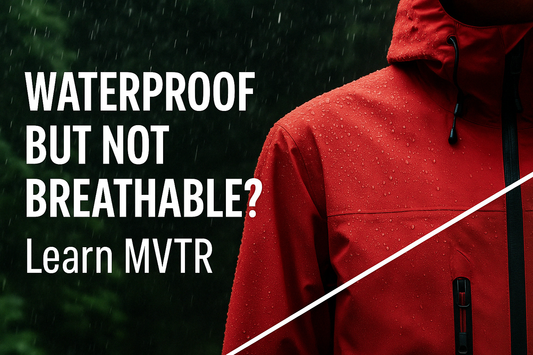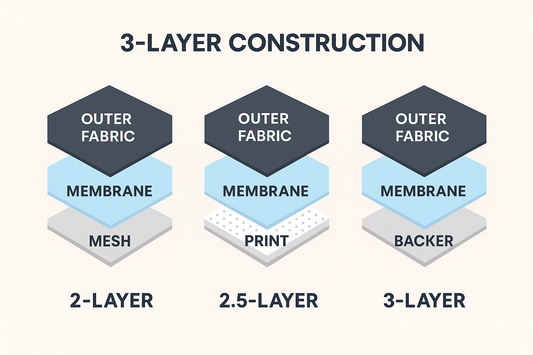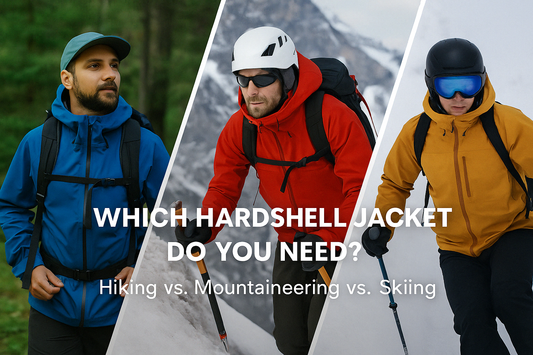
Softshell vs Fleece: What to Wear and When
Share
Fleece keeps you warm; softshell keeps you protected. One traps heat, the other blocks wind and light rain. The trick isn’t choosing one forever — it’s knowing when to wear which.
This guide breaks down how each works, its pros and cons, and how to layer them for real-world comfort. Whether you’re dressing for a chilly city morning or a windy trail, you’ll see how to stay warm, dry, and comfortable — without overthinking what to wear.
What Is a Fleece?
A fleece is a type of fabric and clothing made for warmth, comfort, and breathability. The material is usually 100% polyester that’s been brushed to create a soft, fluffy texture. Those tiny raised fibers trap air, forming a lightweight layer of insulation that keeps heat close to your body without weighing you down.
Unlike wool, it resists moisture and stays warm even when damp. Originally designed for outdoor use, fleece has become a go-to fabric for both performance wear and everyday comfort — perfect for layering, casual wear, or adding warmth under a shell.
-
Is fleece too warm for spring? → Often yes, unless it’s lightweight microfleece.
-
What is the warmest type of fleece? → High-pile or Polartec® Thermal Pro® versions.
- What’s warmer than fleece? → Down or synthetic insulated puffers, like Alpargali Aerogel Graphene Puffer Jacket.
Pros and Cons of Fleece
Pros
-
Warm for its weight: Excellent insulation without feeling heavy.
-
Breathable and quick-drying: Great for active use; won’t cling to sweat.
-
Soft and comfortable: Cozy against the skin, perfect for layering.
-
Easy to care for: Machine-washable and durable; no special treatment needed.
Cons
-
Not windproof: On a breezy day, cold air cuts right through unless you add a shell.
-
Not waterproof: It’ll soak through in steady rain.
-
Can pill over time: Lower-quality fleece may lose its smooth look after repeated wear.
-
Less stylish on its own: Function often wins over form unless it’s a well-designed piece.
In short, fleece is about lightweight warmth and comfort. It’s not meant to protect you from a storm, but it’s unbeatable as a mid-layer or a cozy standalone jacket on a cool, dry day.
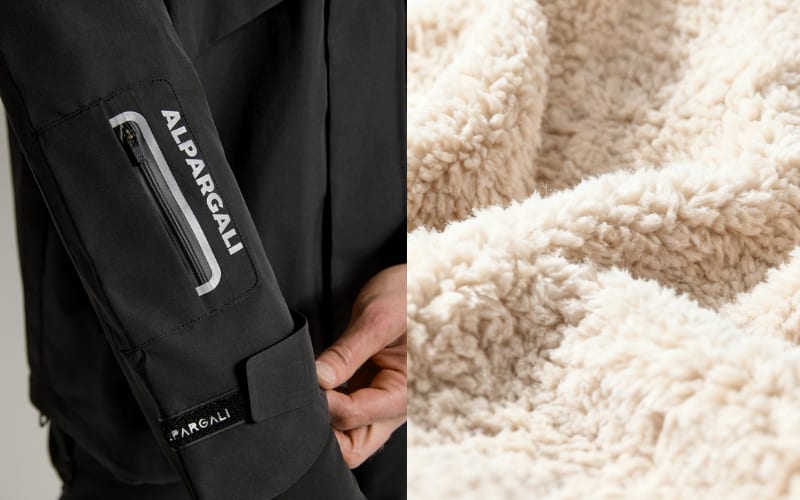
What Is a Softshell?
A softshell is a versatile outer layer designed to balance weather protection and breathability. Made from woven polyester or nylon with stretch fibers, it features a smooth, wind-resistant outer surface and a soft inner lining for comfort. It’s ideal for active use in cool, windy, or mildly wet conditions — the perfect choice when a base layer isn’t enough, but a heavy waterproof shell is too much.
-
What is a softshell jacket good for? → Ideal for hiking, cycling, climbing, or commuting in windy or damp conditions.
-
Is softshell for winter? → Yes, for active cold-weather use.
-
Is softshell good for summer? → Yes, in breathable lightweight versions.
-
Are soft shells warm? → Moderately; they block wind but are not thickly insulated.
- Is softshell waterproof? → Water-resistant, not fully waterproof.
Pros and Cons of Softshell Clothing
Pros
-
Weather resistant: Blocks wind and sheds light rain or snow — ideal for variable conditions.
-
Highly breathable: Prevents overheating during active pursuits.
-
Stretchy and flexible: Moves naturally with your body; perfect for hiking, cycling, or climbing.
-
Durable: Tough outer fabric resists abrasion from backpacks and rough terrain.
-
Versatile style: Sleeker and more structured than fleece, easy to dress up or down.
Cons
-
Not fully waterproof: Can handle drizzle, but not sustained rain.
-
Less insulating than fleece: Provides moderate warmth but not enough for deep winter by itself.
-
Can feel heavier than lightweight fleeces: Especially in lined or reinforced versions.
- More expensive: Technical materials and construction usually come at a higher price.
Softshell vs Fleece: A Complete Comparison
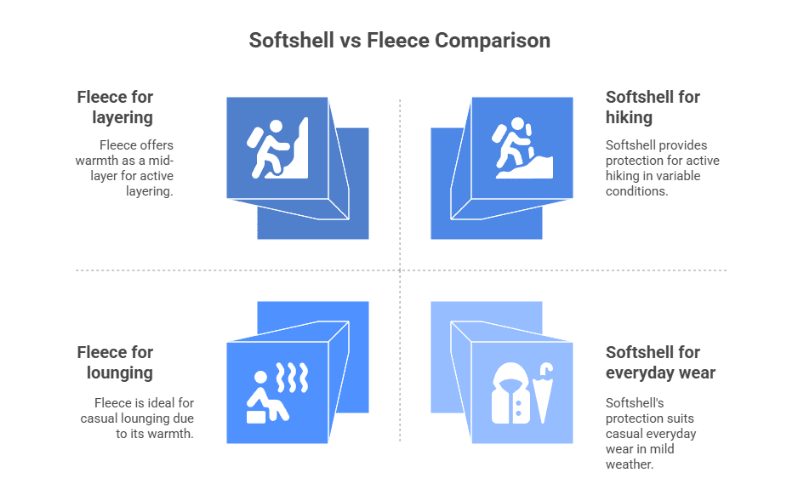
If you’re trying to decide between a softshell and a fleece, the truth is that both have a place in your wardrobe — they simply serve different purposes. One’s built for warmth, the other for protection. Here’s how they stack up in real life.
|
Feature |
Fleece |
Softshell |
|
Core Purpose |
Designed to trap body heat and keep you warm. |
Built to block wind and resist light rain while staying breathable. |
|
Fabric Feel |
Soft, plush, and cozy — brushed polyester that feels like a blanket. |
Smooth, structured, and slightly stretchy — woven polyester or nylon with elastane. |
|
Warmth Level |
Higher insulation; ideal for cold, dry weather. |
Moderate warmth; better for active use or mild winter days. |
|
Breathability |
Excellent — lets air move through easily, great for layering. |
High but controlled — releases sweat without letting cold air flood in. |
|
Wind Resistance |
Low; you’ll feel the breeze. |
High; blocks gusts and keeps warmth sealed in. |
|
Water Resistance |
None — absorbs moisture quickly. |
Water-repellent; can handle drizzle or snow flurries, not a downpour. |
|
Stretch & Movement |
Soft and flexible but not very elastic. |
Four-way stretch in many versions; ideal for climbing, cycling, hiking. |
|
Weight & Packability |
Usually lighter and more compressible. |
Slightly heavier but tougher; often includes added features (zips, pockets, hoods). |
|
Durability |
Can pill or wear thin over time. |
Highly durable — stands up to backpacks and abrasion. |
|
Best Use |
Everyday warmth, base or mid-layer, lounging, dry-cold days. |
Outer layer for active pursuits in windy or variable conditions. |
|
Style Factor |
Casual, sporty, sometimes bulky. | Sleek, structured, easy to pair with jeans or outdoor gear. |
Softshell vs Fleece Clothing
If you’ve ever wondered which one actually performs better — softshell or fleece — the answer depends on what you’re wearing it for. Jacket and vest bring something slightly different to the table.
Softshell vs Fleece Jacket
Here’s the quick truth: fleece keeps you warm, softshell keeps you protected.
A fleece jacket is made to trap body heat. It’s soft, light, and breathable — ideal for dry, chilly days or as a mid-layer under a shell. But fleece offers no real defense against wind or rain. The moment the weather turns damp or breezy, you’ll feel it.
A softshell jacket, on the other hand, is built for movement and protection. Its woven outer fabric blocks wind and sheds light rain, while still letting heat and sweat escape. It’s not as warm as fleece, but it performs better when you’re active or when conditions shift between cool and wet.
Sounds like you can only choose one? No! If you want one jacket that handles both weather and comfort — that’s where Alpargali comes in.
The Alpargali CoreShell was created for the space between fleece and softshell — for those days when you need both warmth and weather resistance, but don’t want the bulk of layering. It combines a dual-layer jacquard fleece interior that feels soft and insulating with a durable, stretch nylon outer that blocks wind and light rain. The result is a jacket that stays about 30% warmer than standard fleece, yet still breathes easily when you’re on the move.
Where fleece alone falls short in a breeze, and softshell can feel too rigid for daily wear, CoreShell sits comfortably in the middle. The waterproof membrane and windproof construction handle real weather, while the far-infrared fleece lining keeps warmth close without overheating. It’s the kind of jacket you put on in the morning — for a windy commute, a light hike, or a cold flight — and forget about because it just works.
In essence, CoreShell isn’t louder, thicker, or flashier — it’s smarter. It takes what fleece and softshell each do best and merges them into one adaptable, all-weather layer built for the rhythm of real life.
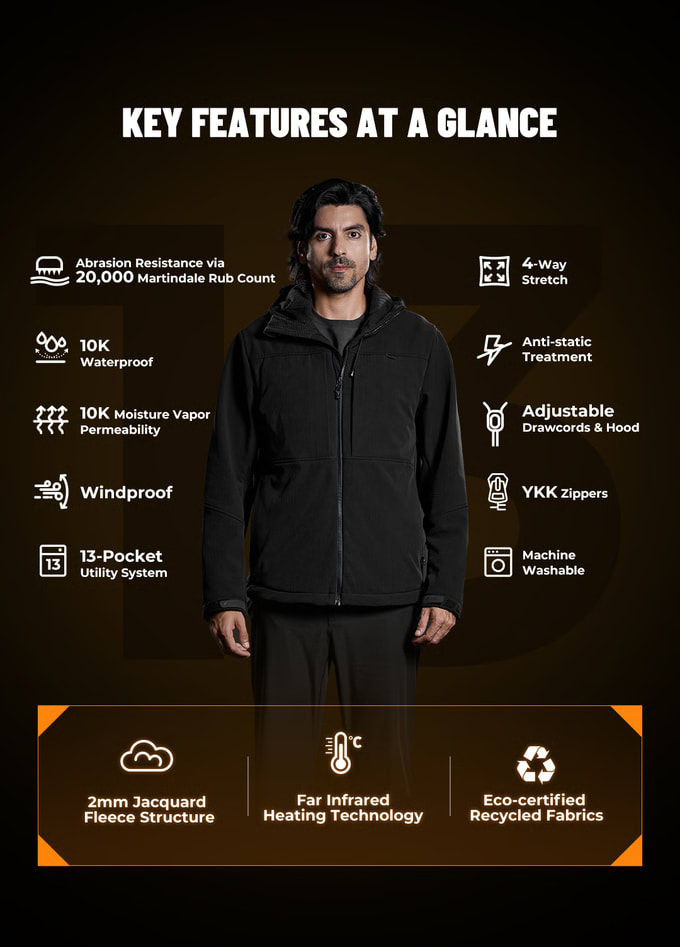
What Is the Difference Between Soft Shell and Fleece Vests?
At first glance, softshell and fleece vests might seem interchangeable — both are sleeveless layers meant to keep your core warm. But once you start moving outdoors, their differences become obvious.
A fleece vest focuses purely on insulation. It traps heat well, feels soft and breathable, and is great for layering under a jacket. The downside: it’s not built for wind or rain. On a calm, dry day, fleece feels perfect; add a breeze or drizzle, and that warmth disappears quickly.
A softshell vest leans toward protection and structure. The woven fabric blocks wind, resists light moisture, and holds its shape better during movement. It’s the more versatile option for outdoor activity — ideal when you’re switching between sun, shade, and wind.
While fleece and softshell serve their roles, Alpargali’s Graphene Vest takes a different approach — one that uses next-generation materials to deliver warmth, durability, and comfort in a more refined, lightweight form.
Instead of traditional insulation, it features a graphene-infused back panel that conducts and retains heat efficiently, keeping your core warm without bulk. Paired with Sorona® eco-insulation, it delivers steady, breathable warmth that feels natural across a range of temperatures.
The exterior is finished with a Teflon™ water- and stain-resistant coating, giving you reliable protection against sudden drizzle or dirt — all while maintaining a clean, minimalist profile.
The design is deliberately simple: slim, easy to layer, and made for movement. It’s a smarter alternative for people who need lightweight, real-world warmth that transitions seamlessly from outdoor activity to daily life.
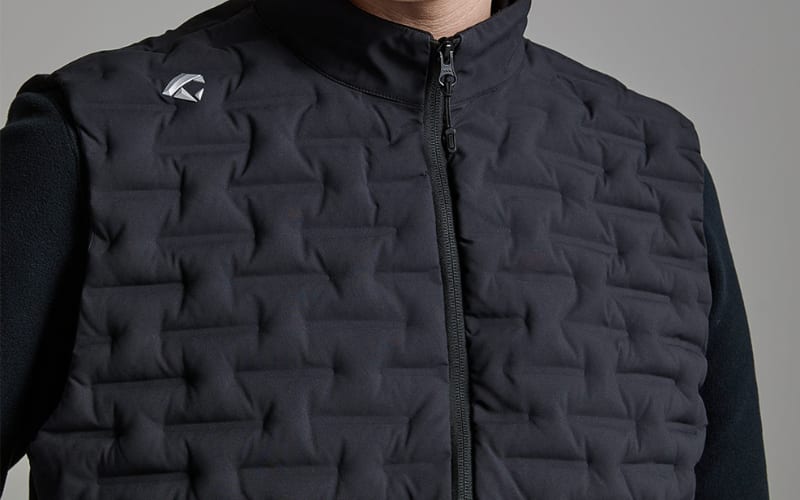
Is Softshell Warmer Than Fleece?
No — fleece is generally warmer because it’s designed to trap heat close to your body. Softshell, by contrast, focuses on blocking wind and shedding light rain, offering protection rather than pure insulation.
How to Layer Softshell and Fleece: A Practical Guide
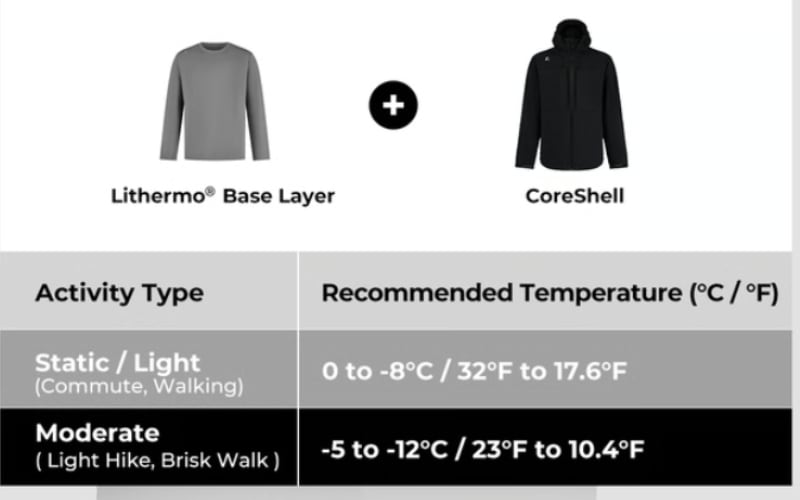
Layering isn’t about owning more jackets — it’s about knowing how to combine the right ones for the weather you’re facing. Both softshell and fleece have their moments: fleece gives you that soft, breathable warmth, while softshell adds structure and protection from wind and light rain. Here’s how to make them work together across real-world conditions.
Mild Weather (10–15°C / 50–59°F)
On those in-between days — a cool breeze, overcast sky, but not quite cold — a softshell on its own is often enough. The fabric keeps out the wind while staying breathable, which makes it perfect for walking, commuting, or even light hikes.
This is the kind of range where a lined softshell like Alpargali’s CoreShell Jacket performs naturally — enough warmth for early mornings, but still ventilated when the temperature rises through the day.
Cool Weather (5–10°C / 41–50°F)
As the air turns crisp, add a light fleece underneath your softshell. The fleece builds gentle insulation while the softshell prevents that warmth from escaping in the wind. For this temperature band, layering a base layer under CoreShell covers most activities — from brisk city walks to weekend rides — staying comfortable without feeling heavy.
Cold Weather (0 to -8°C / 32–17°F)
Now you’re in proper jacket weather. This is where fleece and softshell really work as a system — the fleece traps body heat, the outer shell seals it in. In our field testing, pairing a technical base layer with a lined softshell like CoreShell keeps you comfortable between 0 and -8°C for slow-paced days, and down to -12°C (10°F) when moving more actively.
Deep Winter (-10°C / 14°F and below)
When temperatures plunge or activity slows, it’s time for a three-layer setup: base layer, fleece, and our coreshell. The fleece locks in heat; the outer layer shields from windchill and light snow.
In practice, that setup keeps you steady around -15°C (5°F) when you’re out walking, and as low as -20°C (-4°F) during moderate activity — without needing a heavy parka.
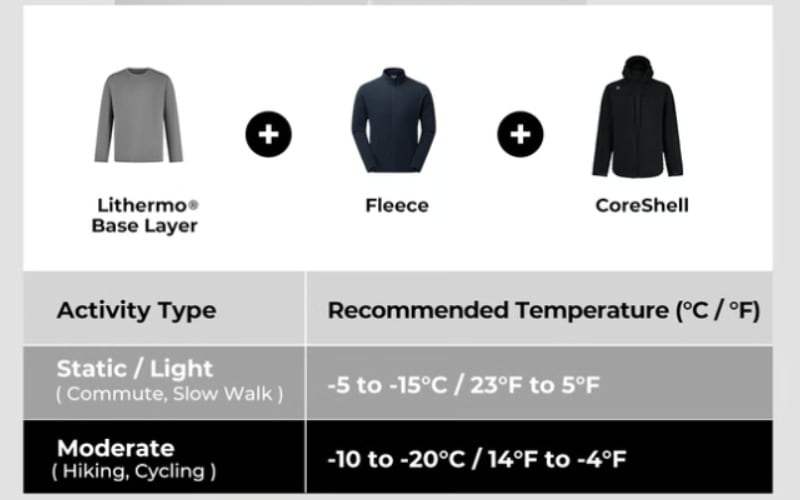
Softshell vs Puffer Jacket
A softshell jacket is built for movement and changing conditions — it blocks wind, resists light rain, and breathes well during active use. A puffer jacket, by contrast, is all about insulation. It traps heat using down or synthetic fill, making it much warmer but less breathable.
Soft Shell vs Rain Jacket
A softshell offers comfort and flexibility — it’s wind-resistant, water-repellent, and great for everyday or active use. A rain jacket, on the other hand, is fully waterproof, designed to withstand steady or heavy rain but with less breathability.
Choosing between fleece and softshell really comes down to what the day looks like. Fleece brings soft, breathable warmth — perfect for dry, cool conditions. Softshell steps in when you need more protection from wind, light rain, or changing weather.
The best setup isn’t about picking one over the other, but understanding how they work together. Once you do, layering becomes simple — and staying comfortable just happens naturally.
Want to see how other materials compare?
Explore more in our Clothing Comparison series, where we break down performance, comfort, and versatility across all-season essentials.
